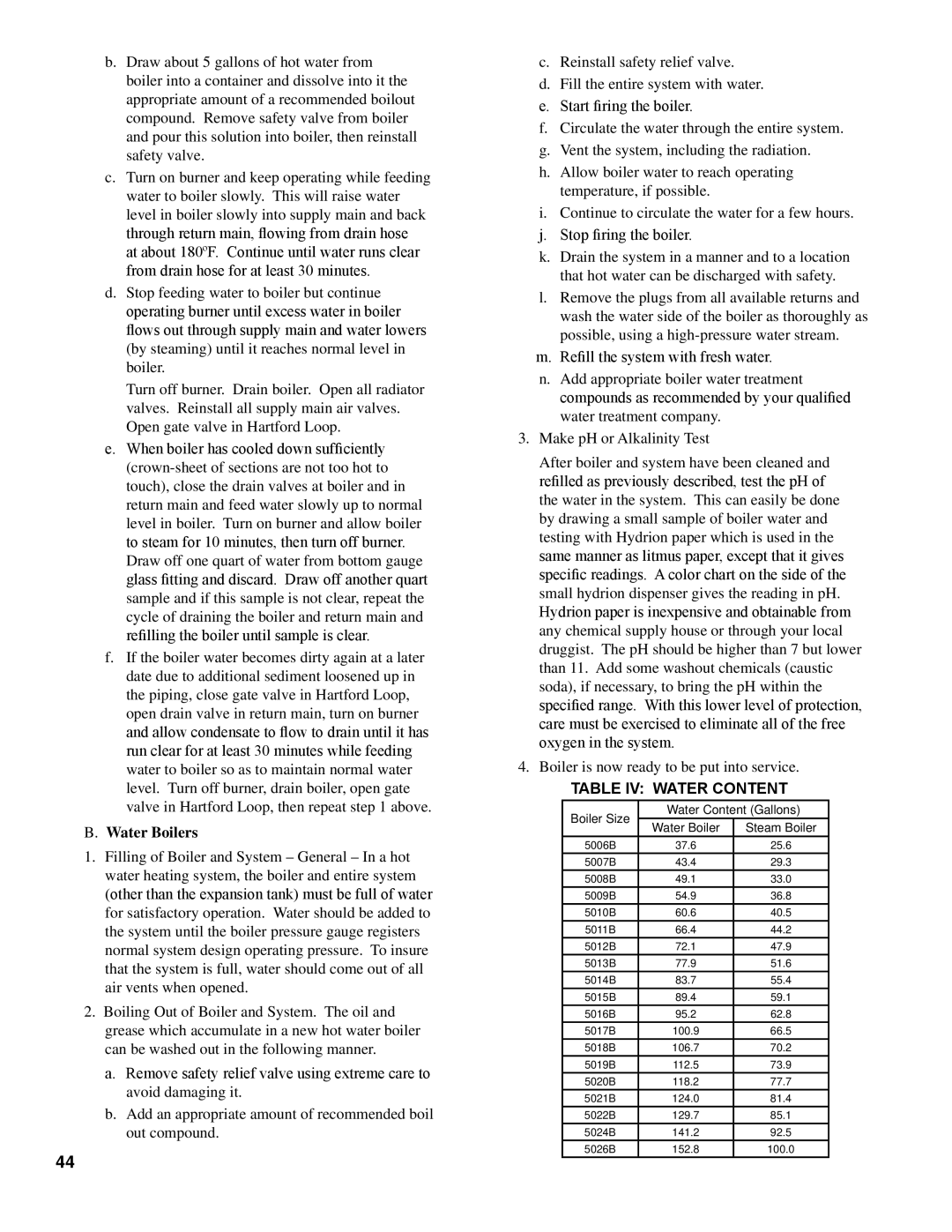b.Draw about 5 gallons of hot water from boiler into a container and dissolve into it the appropriate amount of a recommended boilout compound. Remove safety valve from boiler and pour this solution into boiler, then reinstall safety valve.
c.Turn on burner and keep operating while feeding water to boiler slowly. This will raise water level in boiler slowly into supply main and back through return main, flowing from drain hose at about 180ºF. Continue until water runs clear from drain hose for at least 30 minutes.
d.Stop feeding water to boiler but continue operating burner until excess water in boiler flows out through supply main and water lowers
(by steaming) until it reaches normal level in boiler.
Turn off burner. Drain boiler. Open all radiator valves. Reinstall all supply main air valves. Open gate valve in Hartford Loop.
e.When boiler has cooled down sufficiently
Draw off one quart of water from bottom gauge glass fitting and discard. Draw off another quart sample and if this sample is not clear, repeat the cycle of draining the boiler and return main and refilling the boiler until sample is clear.
f.If the boiler water becomes dirty again at a later date due to additional sediment loosened up in the piping, close gate valve in Hartford Loop, open drain valve in return main, turn on burner and allow condensate to flow to drain until it has run clear for at least 30 minutes while feeding water to boiler so as to maintain normal water level. Turn off burner, drain boiler, open gate valve in Hartford Loop, then repeat step 1 above.
B.Water Boilers
1.Filling of Boiler and System – General – In a hot water heating system, the boiler and entire system
(other than the expansion tank) must be full of water for satisfactory operation. Water should be added to the system until the boiler pressure gauge registers normal system design operating pressure. To insure that the system is full, water should come out of all air vents when opened.
2.Boiling Out of Boiler and System. The oil and grease which accumulate in a new hot water boiler can be washed out in the following manner.
a.Remove safety relief valve using extreme care to avoid damaging it.
b.Add an appropriate amount of recommended boil out compound.
44
c.Reinstall safety relief valve.
d.Fill the entire system with water.
e.Start firing the boiler.
f.Circulate the water through the entire system.
g.Vent the system, including the radiation.
h.Allow boiler water to reach operating temperature, if possible.
i.Continue to circulate the water for a few hours.
j.Stop firing the boiler.
k.Drain the system in a manner and to a location that hot water can be discharged with safety.
l.Remove the plugs from all available returns and wash the water side of the boiler as thoroughly as possible, using a
m.Refill the system with fresh water.
n.Add appropriate boiler water treatment compounds as recommended by your qualified water treatment company.
3.Make pH or Alkalinity Test
After boiler and system have been cleaned and refilled as previously described, test the pH of the water in the system. This can easily be done by drawing a small sample of boiler water and testing with Hydrion paper which is used in the same manner as litmus paper, except that it gives specific readings. A color chart on the side of the small hydrion dispenser gives the reading in pH.
Hydrion paper is inexpensive and obtainable from any chemical supply house or through your local druggist. The pH should be higher than 7 but lower than 11. Add some washout chemicals (caustic soda), if necessary, to bring the pH within the specified range. With this lower level of protection, care must be exercised to eliminate all of the free oxygen in the system.
4.Boiler is now ready to be put into service.
Table IV: Water Content
Boiler Size | Water Content (Gallons) | ||
Water Boiler | Steam Boiler | ||
| |||
5006B | 37.6 | 25.6 | |
5007B | 43.4 | 29.3 | |
5008B | 49.1 | 33.0 | |
5009B | 54.9 | 36.8 | |
5010B | 60.6 | 40.5 | |
5011B | 66.4 | 44.2 | |
5012B | 72.1 | 47.9 | |
5013B | 77.9 | 51.6 | |
5014B | 83.7 | 55.4 | |
5015B | 89.4 | 59.1 | |
5016B | 95.2 | 62.8 | |
5017B | 100.9 | 66.5 | |
5018B | 106.7 | 70.2 | |
5019B | 112.5 | 73.9 | |
5020B | 118.2 | 77.7 | |
5021B | 124.0 | 81.4 | |
5022B | 129.7 | 85.1 | |
5024B | 141.2 | 92.5 | |
5026B | 152.8 | 100.0 | |
